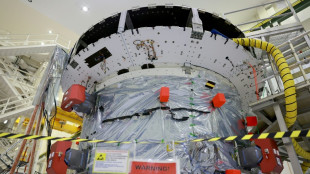-
 India see off Bangladesh to book Asia Cup final spot
India see off Bangladesh to book Asia Cup final spot
-
Rubio calls for Russia to stop the 'killing' in Ukraine

-
 Macron tells Iran president only hours remain to avert nuclear sanctions
Macron tells Iran president only hours remain to avert nuclear sanctions
-
UN humanitarian chief slams impunity in face of Gaza 'horror'

-
 Danish PM apologises to victims of Greenland forced contraception
Danish PM apologises to victims of Greenland forced contraception
-
Planetary health check warns risk of 'destabilising' Earth systems

-
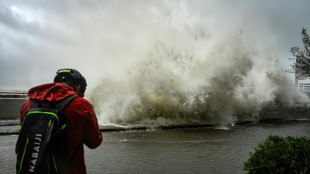 Typhoon Ragasa slams into south China after killing 14 in Taiwan
Typhoon Ragasa slams into south China after killing 14 in Taiwan
-
Monchi exit 'changes nothing' for Emery at Aston Villa

-
 Taiwan lake flood victims spend second night in shelters
Taiwan lake flood victims spend second night in shelters
-
Europe ready for McIlroy taunts from rowdy US Ryder Cup fans

-
 US comedian Kimmel calls Trump threats 'anti-American'
US comedian Kimmel calls Trump threats 'anti-American'
-
Australia win tense cycling mixed relay world title

-
 Stokes will be battle-ready for Ashes, says England chief
Stokes will be battle-ready for Ashes, says England chief
-
Iran will never seek nuclear weapons, president tells UN

-
 Zelensky says NATO membership not automatic protection, praises Trump after shift
Zelensky says NATO membership not automatic protection, praises Trump after shift
-
Becker regrets winning Wimbledon as a teenager

-
 'Mind-readers' Canada use headphones in Women's Rugby World Cup final prep
'Mind-readers' Canada use headphones in Women's Rugby World Cup final prep
-
Rose would welcome Trump on stage if Europe keeps Ryder Cup

-
 AI optimism cheers up markets following Fed rate warning
AI optimism cheers up markets following Fed rate warning
-
France doubles down on threat to build future fighter jet alone
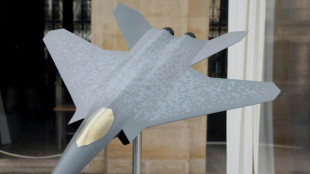
-
 Delay warning issued to fans ahead of Trump's Ryder Cup visit
Delay warning issued to fans ahead of Trump's Ryder Cup visit
-
EU chief backs calls to keep children off social media

-
 US Treasury says in talks to support Argentina's central bank
US Treasury says in talks to support Argentina's central bank
-
'Everything broken': Chinese residents in typhoon path assess damage

-
 Inside Barcelona's Camp Nou chaos: What is happening and why?
Inside Barcelona's Camp Nou chaos: What is happening and why?
-
UK police arrest man after European airports cyberattack

-
 Ballon d'Or disappointment will inspire Yamal: Barca coach Flick
Ballon d'Or disappointment will inspire Yamal: Barca coach Flick
-
French-German duo wins mega offshore wind energy project

-
 Italy deploys frigate after drone 'attack' on Gaza aid flotilla
Italy deploys frigate after drone 'attack' on Gaza aid flotilla
-
Typhoon Ragasa slams into south China after killing 17 in Taiwan
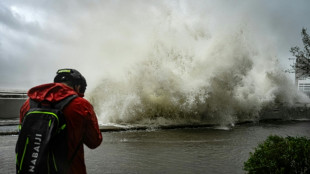
-
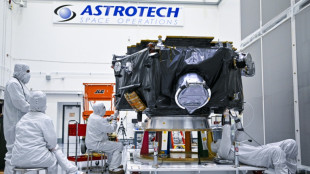 NASA launches mission to study space weather
NASA launches mission to study space weather
-
Stocks torn between Fed rate warning, AI optimism

-
 Russia vows to press offensive, rejects idea Ukraine can retake land
Russia vows to press offensive, rejects idea Ukraine can retake land
-
French consumer group seeks Perrier sales ban

-
 Photographer Arthus-Bertrand rejects image of 'fractured France'
Photographer Arthus-Bertrand rejects image of 'fractured France'
-
Gaza civil defence says dozens killed in Israeli strikes

-
 Pakistan's Shaheen sends Asia Cup warning as third India clash looms
Pakistan's Shaheen sends Asia Cup warning as third India clash looms
-
Amazon to shut checkout-free UK grocery shops

-
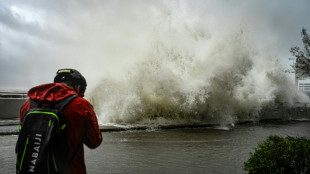 Typhoon Ragasa hits south China after killing 15 in Taiwan
Typhoon Ragasa hits south China after killing 15 in Taiwan
-
Russia vows to press on in Ukraine, rejects Trump jibe

-
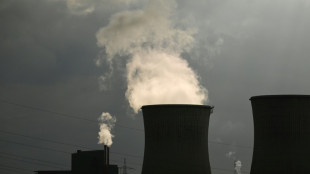 Germany's Merz rejects claims he is slowing green shift
Germany's Merz rejects claims he is slowing green shift
-
Sinner says 'changing a lot' after US Open loss to Alcaraz

-
 Russia-linked disinfo campaign targets Moldovan election
Russia-linked disinfo campaign targets Moldovan election
-
Danish PM to apologise to victims of Greenland forced contraception

-
 Wiretapping scandal goes to court in Greece
Wiretapping scandal goes to court in Greece
-
Ekitike apologises to Liverpool fans after 'stupid' red card

-
 UK rail operators set for new EU border checks
UK rail operators set for new EU border checks
-
S. Korea's ex-first lady goes on trial in corruption case

-
 Modern-day Colombian guerrillas are mere druglords: ex-FARC commander
Modern-day Colombian guerrillas are mere druglords: ex-FARC commander
-
Australian telco giant slapped with $66 million fine over 'appalling' conduct

| RBGPF | -1.74% | 75.29 | $ | |
| CMSC | -0.46% | 24.04 | $ | |
| JRI | -0.24% | 14.006 | $ | |
| BCC | -0.93% | 78.245 | $ | |
| BTI | -1.42% | 52.445 | $ | |
| RIO | 0.87% | 64.13 | $ | |
| NGG | -0.32% | 71.13 | $ | |
| GSK | -0.87% | 40.171 | $ | |
| RYCEF | 0% | 15.75 | $ | |
| SCS | -1.29% | 16.655 | $ | |
| CMSD | 0.08% | 24.34 | $ | |
| AZN | -1.09% | 75.15 | $ | |
| BP | 1.46% | 35.255 | $ | |
| BCE | -0.85% | 23.045 | $ | |
| RELX | -0.35% | 46.31 | $ | |
| VOD | -0.49% | 11.305 | $ |
Vera Rubin observatory reveals stunning first images
Breathtaking stellar nurseries, a sprawling stretch of cosmos teeming with millions of galaxies, and thousands of newly discovered asteroids were revealed Monday in the first deep space images captured by the Vera C. Rubin Observatory in Chile.
More than two decades in the making, the $800 million US-funded telescope sits atop Cerro Pachon in central Chile, where dark skies and dry air provide ideal conditions for observing the cosmos.
One debut image is a composite of 678 exposures taken over seven hours, capturing the Trifid and Lagoon Nebulae -- both several thousand light-years from Earth -- glowing in vivid pinks against orange-red backdrops.
It reveals these birth places of stars in unprecedented detail, with previously faint or invisible features now clearly visible.
Another, dubbed "The Cosmic Treasure Chest," shows the universe "teeming with stars and galaxies -- the seemingly empty black pockets of space between stars in the night sky when you look at it with unaided eyes, are transformed here into these glittering tapestries," said Zeljko Ivezic, director of Rubin construction.
Spiral, elliptical, and clustered galaxies appear in vivid reds, blues, and oranges. These colors reveal key details such as distance and size with unmatched precision, helping scientists better understand the universe's expansion history.
The colors don't directly match what the naked eye would see, explained scientist Federica Bianco, since the telescope captures a far broader range of wavelengths. Instead, they are representational: infrared is mapped to red to represent cooler objects, while ultraviolet is mapped to blue and indicates warmer ones.
- 10-year flagship project -
An interactive version of the image is now available on the Rubin Observatory's website.
"One of the things that is very fun is that if you zoom in and you look at one of the fuzzy galaxies there, you might be the first person to be paying attention to that fuzzy blob," said Clare Higgs, education and public outreach science lead.
The observatory features an advanced 8.4-meter telescope and the largest digital camera ever built, supported by a powerful data system transferring 20 terabytes each night.
Roughly the size of a car, the camera captures 3,200-megapixel images. It would take 400 ultra-high-definition televisions stacked together to view a single Rubin image at full resolution.
Later this year, the observatory will launch its flagship project, the Legacy Survey of Space and Time (LSST). Over the next decade, it will scan the night sky nightly, detecting even the subtlest changes with unmatched precision.
Named after pioneering American astronomer Vera C. Rubin — whose research provided the first conclusive evidence for dark matter — the observatory continues her legacy by making dark matter a central focus of its mission.
Dark energy, an equally mysterious and immensely powerful force, is believed to drive the accelerating expansion of the universe. Together, dark matter and dark energy are thought to make up 95 percent of the cosmos, yet their true nature remains unknown.
"By observing up to 20 billion galaxies, we'll study how light from those distant galaxies has reached us — and nearly every galaxy's light has been bent by the gravitational interaction of dark matter that pervades the universe," said scientist Aaron Roodman. This, he added, will help illuminate these cosmic mysteries.
A joint initiative of the US National Science Foundation and Department of Energy, the observatory is also considered one of the most powerful tools ever built for planetary defense.
In just 10 hours of observation, Rubin discovered 2,104 previously unknown asteroids in our solar system, including seven near-Earth objects -- none of which pose a threat. All other ground- and space-based observatories combined discover about 20,000 new asteroids per year.
- Chilean pride -
Chile hosts telescopes from more than 30 countries, including some of the most advanced astronomical instruments in the world — among them the ALMA Observatory, the most powerful radio telescope on Earth.
Cerro Tololo Observatory helped achieve the landmark discovery of the universe's accelerating expansion -- a breakthrough that earned the 2011 Nobel Prize in Physics.
Another major project, the Extremely Large Telescope, is slated to begin operations in 2027 and promises to probe previously unreachable cosmic distances.
G.Schmid--VB



